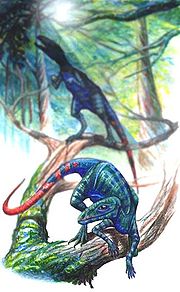
Scleromochlus
Encyclopedia
Scleromochlus is an extinct genus
of small avemetatarsalia
n from the Late Triassic
period. A lightly built cursorial
animal, its phylogenetic position has been debated; as different analyses have found it to be either the basal
-most ornithodiran, the sister-taxon to Pterosauria, or a basal member of Avemetatarsalia that lies outside of Ornithodira.
Scleromochlus is a monotypic genus (single species), which is the type species
S. taylori.
Scleromochlus taylori was about 181 mm (about 7.1 inches) long, with long hind legs; it may have been capable of four-legged and two-legged locomotion.
Its fossils have been found in the Carnian
Lossiemouth Sandstone
of Scotland
. The holotype
is BMNH R3556, a partial skeleton preserved as an impression in sandstone
; part of the skull and tail are missing.

Genus
In biology, a genus is a low-level taxonomic rank used in the biological classification of living and fossil organisms, which is an example of definition by genus and differentia...
of small avemetatarsalia
Avemetatarsalia
Avemetatarsalia is a clade name established by British palaeontologist Michael Benton in 1999 for all crown group archosaurs that are closer to birds than to crocodiles. It includes a similarly defined subgroup, Ornithodira...
n from the Late Triassic
Triassic
The Triassic is a geologic period and system that extends from about 250 to 200 Mya . As the first period of the Mesozoic Era, the Triassic follows the Permian and is followed by the Jurassic. Both the start and end of the Triassic are marked by major extinction events...
period. A lightly built cursorial
Cursorial
Cursorial is a biological term that describes an organism as being adapted specifically to run. It is typically used in conjunction with an animal's feeding habits or another important adaptation. For example, a horse can be considered a "cursorial grazer", while a wolf may be considered a...
animal, its phylogenetic position has been debated; as different analyses have found it to be either the basal
Basal (phylogenetics)
In phylogenetics, a basal clade is the earliest clade to branch in a larger clade; it appears at the base of a cladogram.A basal group forms an outgroup to the rest of the clade, such as in the following example:...
-most ornithodiran, the sister-taxon to Pterosauria, or a basal member of Avemetatarsalia that lies outside of Ornithodira.
Scleromochlus is a monotypic genus (single species), which is the type species
Type species
In biological nomenclature, a type species is both a concept and a practical system which is used in the classification and nomenclature of animals and plants. The value of a "type species" lies in the fact that it makes clear what is meant by a particular genus name. A type species is the species...
S. taylori.
Scleromochlus taylori was about 181 mm (about 7.1 inches) long, with long hind legs; it may have been capable of four-legged and two-legged locomotion.
Its fossils have been found in the Carnian
Carnian
The Carnian is the lowermost stage of the Upper Triassic series . It lasted from about 228.7 till 216.5 million years ago . The Carnian is preceded by the Ladinian and is followed by the Norian...
Lossiemouth Sandstone
Lossiemouth Sandstone
The Lossiemouth Sandstone is a Late Triassic geologic formation. Dinosaur remains are among the fossils that have been recovered from the formation.-Paleofauna:-See also:* List of dinosaur-bearing rock formations...
of Scotland
Scotland
Scotland is a country that is part of the United Kingdom. Occupying the northern third of the island of Great Britain, it shares a border with England to the south and is bounded by the North Sea to the east, the Atlantic Ocean to the north and west, and the North Channel and Irish Sea to the...
. The holotype
Holotype
A holotype is a single physical example of an organism, known to have been used when the species was formally described. It is either the single such physical example or one of several such, but explicitly designated as the holotype...
is BMNH R3556, a partial skeleton preserved as an impression in sandstone
Sandstone
Sandstone is a sedimentary rock composed mainly of sand-sized minerals or rock grains.Most sandstone is composed of quartz and/or feldspar because these are the most common minerals in the Earth's crust. Like sand, sandstone may be any colour, but the most common colours are tan, brown, yellow,...
; part of the skull and tail are missing.


